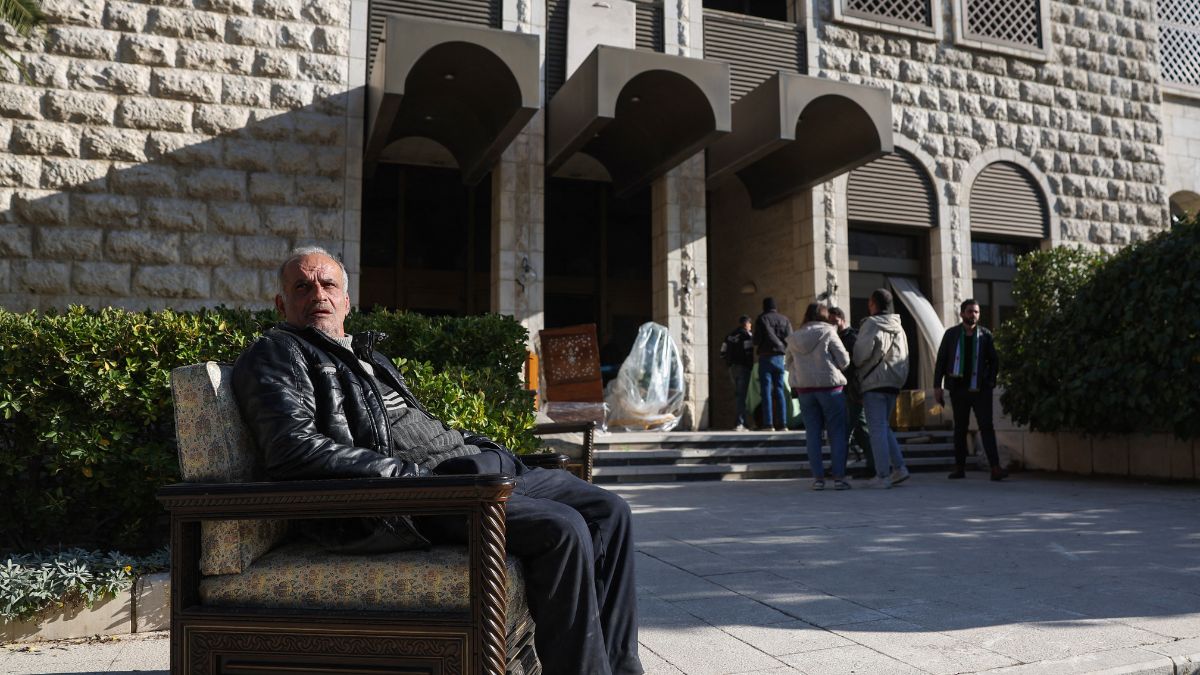The Assad family’s 50-year rule in Syria ended after a sudden rebel offensive that captured government-held areas and reached the capital within ten days. President Bashar al-Assad was ousted and fled the country.
Shortly after, Syrians entered his abandoned presidential palace in Damascus, looted valuables, posed at his desk, and found a collection of luxury cars.
ALSO READ | Explained: What led to Bashar al-Assad's downfall in Syria?
Damascus remained calm overnight under a rebel-imposed curfew. Roads into the city were largely deserted. On Sunday, a shopping centre was looted, and some individuals raided the presidential palace.
What happened inside the Presidential palace?
Verified videos from news agency Reuters showed citizens walking through the luxurious Al-Rawda and Muhajreen palaces.
Children ran through the grand halls of the Al-Rawda Palace as men carried chairs and slid trunks across its lavish floors, visuals from the scene showed. At the Muhajreen Palace, footage showed groups of people walking through rooms with marble floors and tall wooden doors, some carrying vases and decorative items while emptying cupboards and cabinets.
One clip showed looters flaunting Assad’s extensive collection of luxury cars, featuring Ferraris, Aston Martins, Rolls-Royces, BMWs, Mercedes, and what appeared to be a Bugatti Veyron.
Former Syrian regime leader Assad, who fled Syria, hoarded luxury vehicles in his palace while Syrians struggled to survive by scavenging through garbage in other countries.
— Abdullah Tanriverdi (@xjourno) December 8, 2024
I spot Lambo LM002, DB9, Ferrari F50, F430, Countach, Audi R8, SLS, Continental GT, Phantom, Audi Q8 + pic.twitter.com/PGEDDKmWjS
In another video, two rebel fighters fired automatic rifles into the sky as they entered the palace, which is perched on a hill overlooking western Damascus, Daily Telegraph reported. Several other videos captured five fighters roaming the marble-floored halls of the massive 510,000-square-metre complex, comprising three six-storey structures.
ALSO READ | Why Syria’s Bashar al-Assad fled to Russia after rebels led to his fall
The palace corridors were decorated with expensive paintings and ornate wooden furniture, visuals showed. Inside the bathroom, the fighters found a jacuzzi, while in the master bedroom, they found a functioning telephone and a list of phone numbers.
Residents of Damascus celebrated in the streets as rebels declared, “We declare the city of Damascus free.”
Assad family portraits were defaced, and parts of the palace were vandalised.
“I am taking pictures because I am so happy to be here in the middle of his house,” a 44-year-old man said, showing photos on his phone.
“I came for revenge. They oppressed us in incredible ways,” he added.
The looting of #Syria’s presidential palace continues. In this video you can see what looks like Assad’s suits and Asma’s shoes in their living quarters. pic.twitter.com/fkBBjqFGT9
— Jason Brodsky (@JasonMBrodsky) December 8, 2024
‘Sale! Sale!’
On Sunday, several videos circulated online that showed crowds exploring the once-restricted bedrooms of the Assad residence. People were seen grabbing clothes, plates, and other items, including a Louis Vuitton cardboard shopping bag.
In one video, a man was heard shouting, “Sale! Sale!”
Umm Nader, 35, visited the residence with her husband from a nearby district. The residence, once a symbol of fear and power, was now described by one visitor as a “museum.”
“I came to see this place that we were banned from because they wanted us to live in poverty and deprivation,” she told AFP.
Nader stated that the heating and electricity in the residence had been left on, adding, “Meanwhile, our children are getting sick from the cold.”
ALSO READ | What is the role of foreign armies in the Syria conflict? Who's fighting with whom?
Statue of Assad’s father toppled
Earlier, videos showed protesters dragging statues of former President Hafez al-Assad, Bashar al-Assad’s father, through the streets of Damascus in a strong show of support for opposition forces.
Hafez al-Assad seized power in a 1970 coup and served as President until he died in 2000, after which his son Bashar took over and ruled Syria for over two decades before being overthrown.
In Hama, 200 km from Damascus, protesters pulled down and destroyed a statue of Hafez al-Assad amid cheers and loud slogans.
In another video, the decapitated head of the statue was tied to a vehicle and dragged through the streets. Protesters were seen sitting on the statue, kicking it, and chasing after it in mockery.
Similar scenes were reported in Latakia, where a statue of the former President was toppled as celebrations erupted in the city.
The fall of Assad
Thousands of Syrians flooded the streets, celebrating with gunfire and waving the revolutionary flag in scenes similar to that of the early Arab Spring uprising. This marked the end of nearly 14 years of civil war triggered by a brutal crackdown and insurgency.
Soldiers and police abandoned their posts, while looters ransacked the Defence Ministry. Other parts of Damascus were empty and shops shuttered.
Russia, Iran, and Hezbollah, Assad’s key allies, withdrew their support as they faced challenges from other conflicts. Iran, weakened by ongoing clashes with Israel, issued a statement saying Syrians should determine their future “without destructive, coercive, foreign intervention.” The Iranian Embassy in Damascus was abandoned and later ransacked.
Syrian Prime Minister Mohammed Ghazi Jalali announced that the government was prepared to “extend its hand” to the opposition and transfer authority to a transitional government. Opposition media released footage showing armed men escorting him from his office to a hotel.
Russian state media confirmed that Assad had fled to Moscow, where he was granted asylum “out of humanitarian considerations.” This ended speculation about his whereabouts following the rebel takeover of Damascus.
Russia, a staunch Assad ally with two critical military bases in Syria, had intervened in the civil war to support his regime. However, it failed to prevent the collapse of his government amid a rapid rebel advance. The offensive exploited distractions faced by Iran and Hezbollah, Assad’s key regional supporters.
With inputs from agencies


)

)
)
)
)
)
)
)
)



